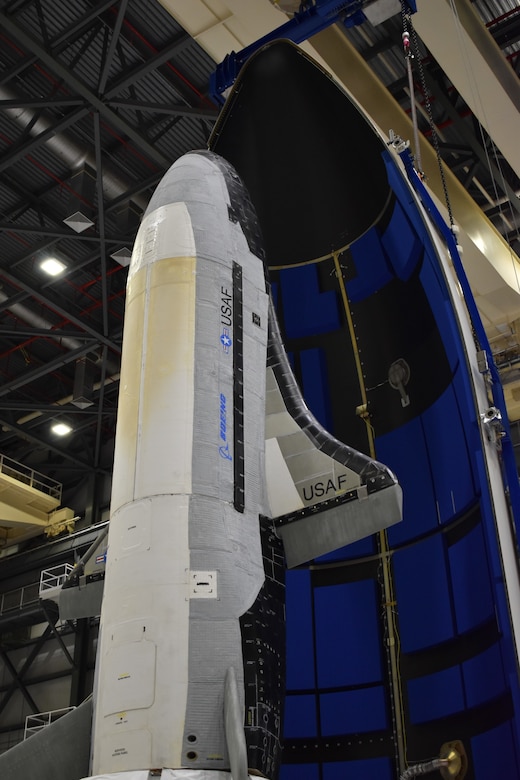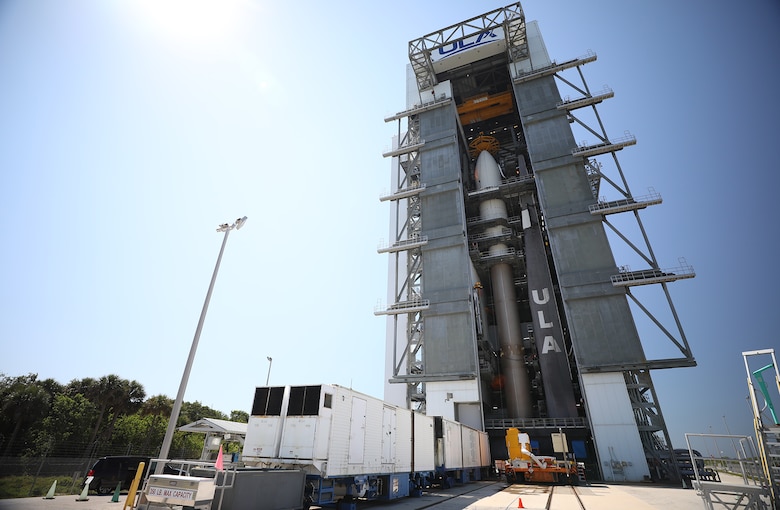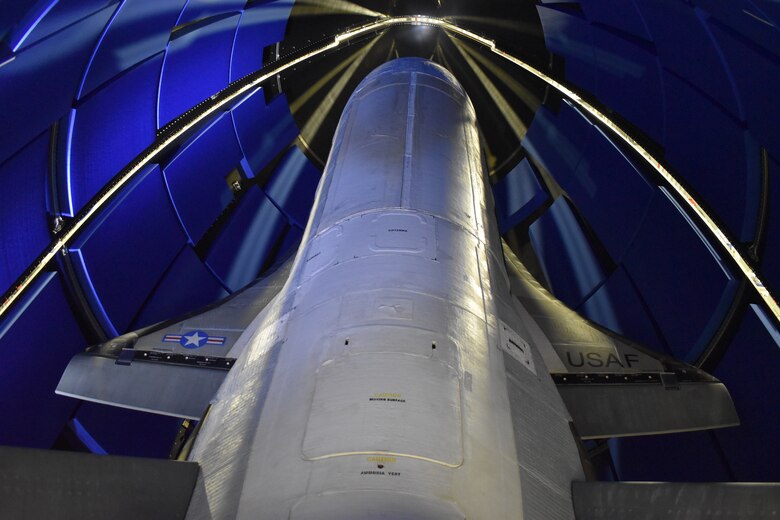7.05.2020
US Space Force to launch the next X-37B space plane mystery mission on May 16
The sixth X-37B flight will carry more experiments than any previous program mission.
The U.S. military's mysterious X-37B space plane is just 10 days away from launching on its next mission.
The X-37B is scheduled to lift off atop a United Launch Alliance Atlas V rocketfrom Florida's Cape Canaveral Air Force Station on May 16, kicking off the sixth mission for the robotic vehicle, Space Force and Air Force officials announced today (May 6).
"This important mission will host more experiments than any prior X-37B flight, including two NASA experiments," Secretary of the Air Force Barbara Barrett said today during a webinar hosted by the nonprofit Space Foundation.

One of those NASA payloads will examine the effects of space radiation on seeds, and the other will assess the performance of various materials in the space environment, Barrett explained.
Another experiment, designed by the U.S. Naval Research Laboratory, "transforms solar power into radio-frequency microwave energy, then studies transmitting that energy to Earth," she said.

The upcoming mission, known as OTV-6 (short for "Orbital Test Vehicle-6") and Space Force-7, will also deploy FalconSat-8, a small satellite developed by the U.S. Air Force Academy that itself carries five separate experiments.
To accommodate these and other payloads, the space plane has been outfitted with a service module for OTV-6 — a first for the X-37B program, Air Force officials said in a statement today.
The Air Force has two X-37B vehicles that we know of, both of which were built by Boeing. The vehicles look like NASA's old space shuttle orbiters, only much smaller. Each X-37B is 29 feet (8.8 meters) long by 9.5 feet (2.9 m) tall, with a wingspan of about 15 feet (4.6 m) and a payload bay the size of a pickup truck bed.
For comparison, each space shuttle was 122 feet (37 m) long with a wingspan of 78 feet (24 m).

The X-37B allows the U.S. military to test a variety of new tech in the space environment and return the gear to the ground for analysis. Many of the payloads that go up are classified, and military officials tend not to disclose many details of the vehicles' activities in orbit.
"The X-37B team continues to exemplify the kind of lean, agile and forward-leaning technology development we need as a nation in the space domain," Gen. Jay Raymond, the U.S. Space Force Chief of Space Operations, said in today's statement. (The newly formed Space Force, which is part of the Department of the Air Force, is responsible for X-37B launches, orbital operations and landings.)
"Each launch represents a significant milestone and advancement in terms of how we build, test and deploy space capabilities in a rapid and responsive manner," Raymond added.
It's unclear how long OTV-6 will last, but precedent suggests that the mission will be a sustained one. Each OTV flight has broken duration records for the program, and OTV-5, which landed in October 2019, circled Earth for 780 days.
The five previous X-37B missions racked up a combined 2,865 days in orbit, Barrett said. That's about 7 years and 10 months of off-Earth technology testing.
Quelle: SC
+++
X-37B spaceplane to carry DoD and NASA experiments in upcoming mission

WASHINGTON — The sixth mission of the U.S. Air Force’s reusable X-37B spaceplane is scheduled to launch May 16 from Cape Canaveral Air Force Station, Florida.
The X-37B Operational Test Vehicle 6 will be launched to low Earth orbit on a United Launch Alliance Atlas 5 rocket. The Air Force Rapid Capabilities Office owns the Boeing-made spaceplane, which flies and lands autonomously. The U.S. Space Force is responsible for the launch, on-orbit operations and landing of the vehicle.
OTV 6 will carry more experiments than any of the previous X-37B missions, Air Force Secretary Barbara Barrett said May 6 during an online event hosted by the Space Foundation.
Randy Walden, director of the Air Force Rapid Capabilities Office, said the upcoming X-37B mission will be the first to use a service module to host experiments. The service module is an attachment to the aft of the vehicle and “enables us to continue to expand the capabilities of the spacecraft and host more experiments than any of the previous missions,” he said in a statement.
One of the experimental payloads is FalconSat-8, a small satellite developed by the U.S. Air Force Academy and funded by the Air Force Research Laboratory. The FalconSat-8 will carry five science payloads. There are also two NASA experiments to study the results of radiation and other space effects on a materials sample plate and seeds used to grow food. A U.S. Naval Research Laboratory experiment will transform solar power into radio frequency microwave energy which could then be transmitted to the ground.
The Atlas 5 rocket will fly in the 501 configuration with a five-meter fairing, a single-engine upper stage and no solid rocket motors. The mission is named USSF-7.
The design and landing profile of the X-37B — weighing about 11,000 pounds and nearly 29-foot long — is similar to NASA’s Space Shuttle but it’s one-fourth the size. The most recent mission OTV 5 was launched Sept. 7, 2017 on a SpaceX Falcon 9 rocket from NASA’s Kennedy Space Center. It landed on October 27, 2019.
Quelle: SN
+++
Next X-37B Orbital Test Vehicle Scheduled to Launch
The Department of the Air Force continues to push the flight envelope for the X-37B, and will build upon its growing collaboration with experiment partners with its sixth mission.
“In today’s age of electrons, space systems track storms, locate stranded motorists, timestamp credit card transactions, and monitor treaty compliance,” said Secretary of the Air Force Barbara Barrett. “Demonstrating the department’s innovation, this X-37B mission will host more experiments than any prior missions. This launch also demonstrates the department’s collaboration that pushes the boundaries for reusable space systems.”
The ability to test new systems in space and return them to Earth is unique to the X-37B program and enables the U.S. to more efficiently and effectively develop space capabilities necessary to maintain superiority in the space domain.
"The X-37B team continues to exemplify the kind of lean, agile and forward-leaning technology development we need as a nation in the space domain," said U.S. Space Force Chief of Space Operations, Gen. John "Jay" Raymond. "Each launch represents a significant milestone and advancement in terms of how we build, test, and deploy space capabilities in a rapid and responsive manner."
The X-37B remains a Department of the Air Force asset; however, the U.S. Space Force is responsible for the launch, on-orbit operations, and landing.
"This launch is a prime example of integrated operations between the Air Force, Space Force, and government-industry partnerships," said Air Force Chief of Staff Gen. David Goldfein. "The X-37B continues to break barriers in advancing reusable space vehicle technologies and is a significant investment in advancing future space capabilities."
This will be the first X-37B mission to use a service module to host experiments. The service module is an attachment to the aft of the vehicle that allows additional experimental payload capability to be carried to orbit.
"This sixth mission is a big step for the X-37B program," said Mr. Randy Walden, Director and Program Executive Officer for the Department of the Air Force Rapid Capabilities Office. "This will be the first X-37B mission to use a service module to host experiments. The incorporation of a service module on this mission enables us to continue to expand the capabilities of the spacecraft and host more experiments than any of the previous missions."
The mission will deploy the FalconSat-8, a small satellite developed by the U.S. Air Force Academy and sponsored by the Air Force Research Laboratory to conduct several experiments on orbit. The FalconSat-8 is an educational platform that will carry five experimental payloads for USAFA to operate. In addition, two National Aeronautics and Space Administration experiments will be included to study the results of radiation and other space effects on a materials sample plate and seeds used to grow food. Finally, the U.S. Naval Research Laboratory, will transform solar power into radio frequency microwave energy which could then be transmitted to the ground.
"We are excited to return the X-37B to space and conduct numerous on-orbit experiments for both the Air Force and its mission partners," said Lt. Col. Jonathan Keen, the X-37B program manager.
The X-37B program completed its fifth mission in October 2019, landing after 780 days on orbit, extending the total number of days spent on orbit for the spacecraft to 2,865 - or seven years and 10 months.
Space Force will test solar power transmission during X-37B space plane’s next mystery flight

When a Boeing-built X-37B space plane is sent into orbit this month for the test program’s sixth flight, it will try out a technology that’s been more than a decade in the making: space-based solar power.
An experiment designed by the U.S. Naval Research Laboratory will transform solar power into a microwave beam for transmission down to the ground. If such a power-beaming system could be perfected, concentrated microwave energy from space could conceivably be converted to electricity for far-flung military outposts.
Back in 2007, the Pentagon issued a report saying the U.S. military could be an “anchor tenant customer” for space-based power generation systems. That report piggybacked on a NASA study that was written a decade earlier, assessing the feasibility of wireless power transmission from space.
The X-37B’s power-beaming experiment would follow up on a small-scale test that was conducted aboard the International Space Station in February. During that demonstration, astronauts made use of the Naval Research Laboratory’s light-emitting rectifying antenna, known as LEctenna, to convert a wireless data signal into enough electrical power to make an LED light glow.
The X-37B program itself is a grand experiment. Over the course of the past decade, the Pentagon’s two space planes have taken on five autonomous test missions in orbit, including a marathon flight that lasted 780 days and ended with a runway landing last October. The program’s total time spent in space adds up to 2,865 days — or seven years and 10 months.
In the past, the stubby-winged craft has been launched into space on United Launch Alliance’s Atlas 5 rocket or SpaceX’s Falcon 9 rocket. The next launch will be atop an Atlas 5, set for liftoff from Cape Canaveral Air Force Station in Florida on May 16.
The reusable space plane’s purpose has been somewhat shrouded in secrecy, but in recent years, military officials have been more forthcoming about its use as a testbed for military space technologies — including novel approaches to propulsion and communications.
“This X-37B mission will host more experiments than any prior missions,” Air Force Secretary Barbara Barrett said today in a news release. “This launch also demonstrates the department’s collaboration that pushes the boundaries for reusable space systems.”
Although the mini-space shuttles are considered assets of the Department of the Air Force, the recently created U.S. Space Force will be in charge of launch, on-orbit operations and landing for this mission, known as OTV-6 or USSF-7.
Gen. John “Jay” Raymond, the Space Force’s chief of space operations, said the X-37 team “continues to exemplify the kind of lean, agile and forward-leaning technology development we need as a nation in the space domain.”
This will be the first X-37B to host experiments in a service module attached to the aft of the plane.
“The incorporation of a service module on this mission enables us to continue to expand the capabilities of the spacecraft and host more experiments than any of the previous missions,” said Randy Walden, director and program executive officer for the Department of the Air Force Rapid Capabilities Office.
In addition to the power-beaming experiment, the X-37 will carry two NASA experiments aimed at gauging the effects of the high-radiation space environment on samples of spacecraft materials and on seeds used to grow food.
The mission will also deploy FalconSat-8, a small satellite developed by the U.S. Air Force Academy and sponsored by the Air Force Research Laboratory. FalconSat-8 will carry five experimental payloads, including an advanced thruster system.
Quelle: GeekWire
----
Update: 9.05.2020
.
Atlas Rocket Stacked for May 16 Launch with X-37B Spaceplane


United Launch Alliance (ULA) has completed another significant step towards its next mission from the Space Coast, as a 197-foot-tall (60-meter) Atlas V booster now stands fully stacked and primed for its opening launch attempt in ten days’ time. Late last month, a “streamlined two-day process” completed the assembly of the giant rocket in the Vertical Integration Facility (VIF) at Space Launch Complex (SLC)-41 at Cape Canaveral Air Force Station, Fla. And earlier today (Wednesday, 6 May), the two-piece, “bisector” payload fairing—containing the Boeing-built X-37B mini-shuttle—was installed atop the booster.
-
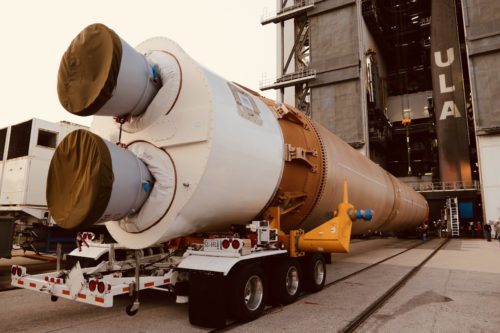
The 107-foot-long (32-meter) Common Booster Core (CBC) approaches the doorway of the Vertical Integration Facility (VIF) at Space Launch Complex (SLC)-41 during the recent Launch Vehicle On Stand (LVOS) processing milestone. Photo Credit: ULA
Liftoff of ULA’s third mission of 2020—which comes hard on the heels of February’s long-awaited Solar Orbiter and March’s flight of the last Advanced Extremely High Frequency (AEHF) satellite for the newly-formed U.S. Space Force—is tentatively planned for Saturday, 16 May. Designated U.S. Space Force (USSF)-7, the Atlas V will deliver the highly secretive X-37B into orbit for its sixth long-duration flight in a little more than a decade. Uniquely, the mission will also incorporate an aft-mounted “service module” to expand the spacecraft’s payload envelope.
“In today’s age of electrons, space systems track storms, locate stranded motorists, timestamp credit card transactions and monitor treaty compliance,” said Secretary of the Air Force Barbara Barrett. “Demonstrating the department’s innovation, this X-37B mission will host more experiments than any prior missions. This launch also demonstrates the department’s collaboration that pushes the boundaries for reusable space systems.”
-
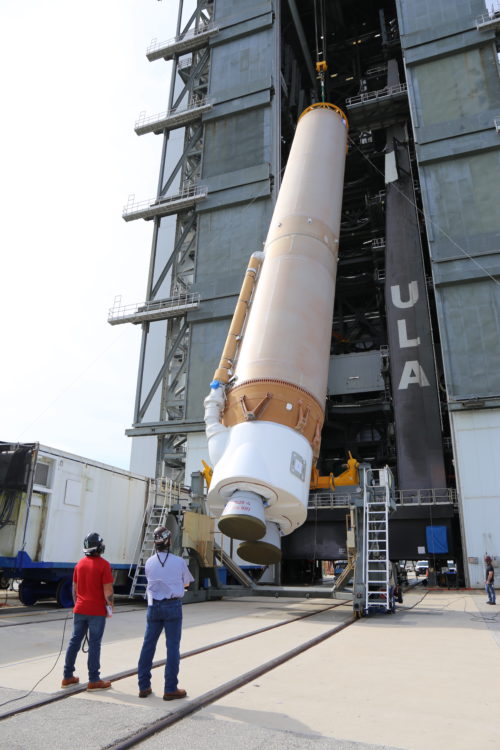
The dual nozzles of the RD-180 engine at the base of the CCB produce 860,000 pounds (390,000 kg) of propulsive yield at liftoff. Photo Credit: ULA
“The X-37B team continues to exemplify the kind of lean, agile and forward-leaning technology development we need as a nation in the space domain,” said U.S. Space Force Chief of Space Operations, Gen. John “Jay” Raymond. “Each launch represents a significant milestone and advancement in terms of how we build, test and deploy space capabilities in a rapid and responsive manner.”
Preparations for the flight entered high gear last October, when the 107-foot-long (32-meter) Common Core Booster (CCB) for the Atlas V arrived aboard ULA’s RocketShip vessel from the factory in Decatur, Ala. Also delivered to the Cape was the 41-foot-long (12.6-meter) Centaur upper stage. The two components immediately parted ways, with the CCB heading to the holding bay of the Atlas Spaceflight Operations Center (ASOC) for processing. With the steady worldwide march of the COVID-19 coronavirus having forced lengthy delays to several other missions from the East Coast, USSF-7 now stands in pole position as the next military flight for the U.S. Space Force, the youngest member of the United States armed services.
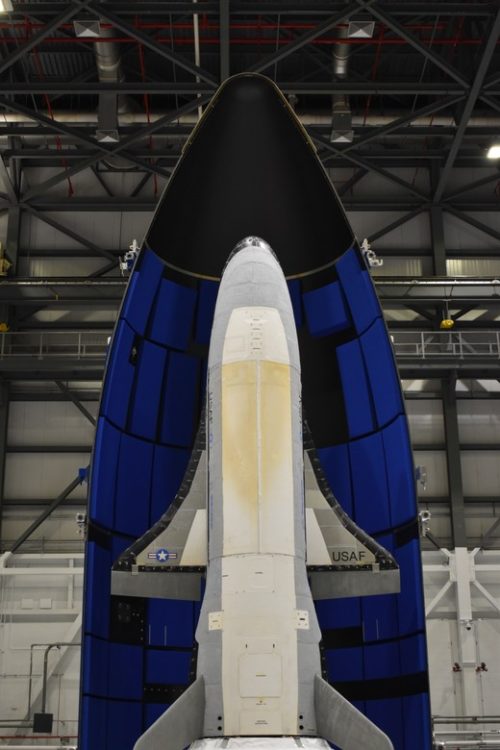
“Conducting the USSF-7 launch with the X-37B Orbital Test Vehicle was deemed critical to perform during this national emergency,” noted ULA in an update earlier Wednesday. “Personnel involved in the launch are following health guidelines such as wearing face coverings, adhering to physical distancing while on console and using virtual connections when possible.”
Just before dawn on 23 April, ULA began its Launch Vehicle On Stand (LVOS) milestone, which saw the Atlas V CCB transferred horizontally atop a semi-truck from the ASOC to the door of the VIF. It was hoisted upright by overhead cranes and secured onto the Mobile Launch Platform (MLP) by means of three support pedestals. Two days later, the Off-Site Vertical Integration (OVI) pre-assembled unit—which comprises the Centaur upper stage, the rocket’s inter-stage adapter and the lower half of the payload fairing—arrived at the VIF and were installed atop the CCB in a process which concluded Monday, 27 April.
“In the early years of Atlas V operations, each piece was added one-by-one to the rocket in the VIF by way of multiple days of crane operations,” ULA explained of the intricate procedure. “ULA has since moved to the more efficient process of connecting these pieces together in a separate facility and bringing the finished element to the VIF for one crane-lift.” With the final topping-off of the booster with the payload fairing and the X-37B on 6 May, the coming days will be spent performing integrated tests of the assembly stack.
The Atlas V booster for the USSF-7 mission will be flying for the seventh time in its so-called “501” configuration, equipped with a 16-foot-diameter (5-meter) payload fairing, no strap-on rockets and the single-engine Centaur upper stage. This particular configuration can lift around 17,800 pounds (8,100 kg) to low-Earth orbit and up to 8,300 pounds (3,770 kg) to geostationary altitude has been used rather sparingly over the years. It saw its last mission to deliver the fourth X-37B to orbit back in May 2015.
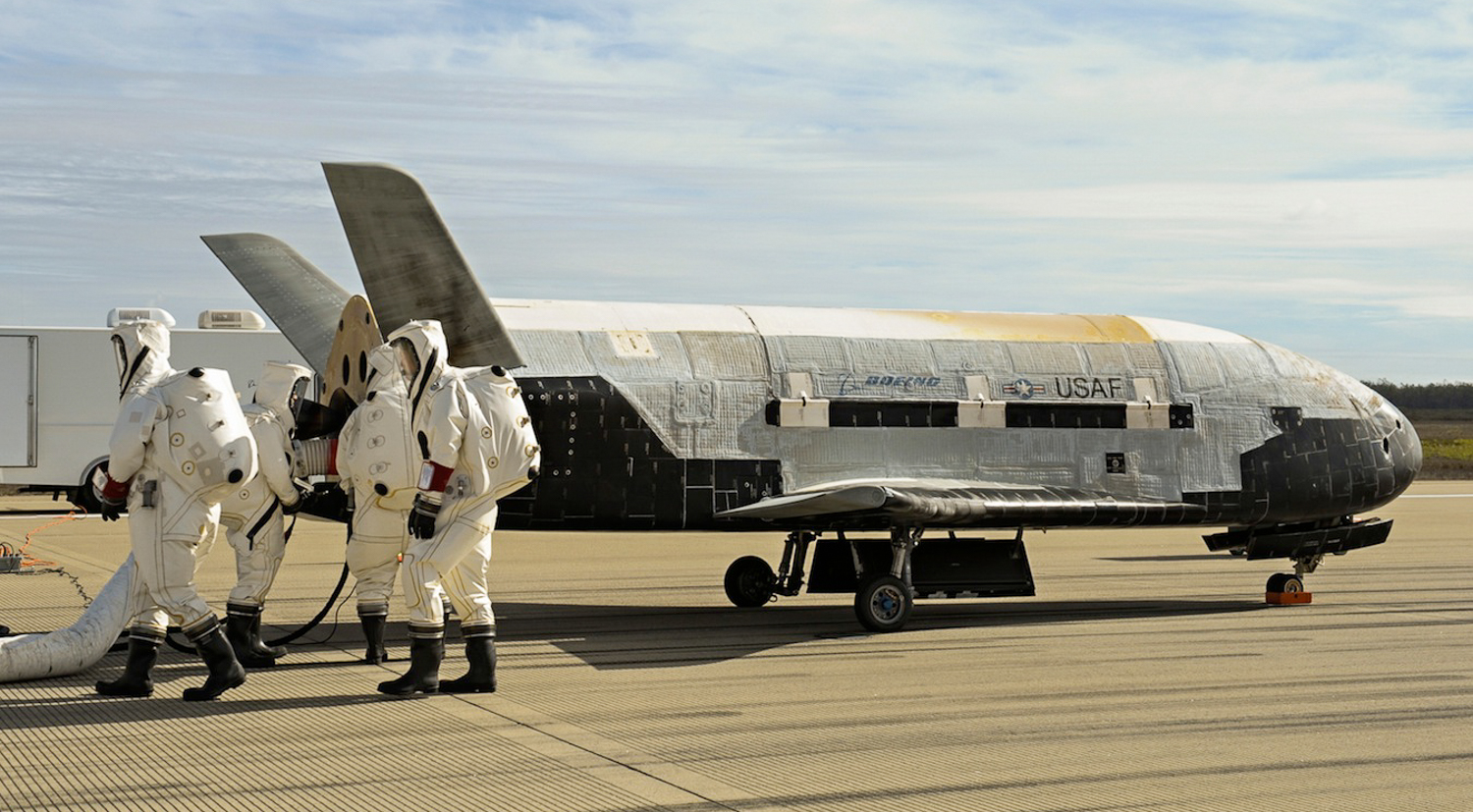
Indeed, four Atlas V 501 missions—including its very first outing, way back in April 2010—have been used exclusively to lift X-37Bs, with two others dedicated to launching a pair of classified payloads for the National Reconnaissance Office. In fact, with the exception of the most recent X-37B, which rode atop a SpaceX Falcon 9 in late 2017, each of these top-secret mini-shuttle missions have flown atop the Atlas V 501.
The physical likeness between the X-37B and NASA’s now-retired Space Shuttle is somewhat misleading. Notably, it is significantly smaller than its predecessor, measuring some 29 feet (8.8 meters) in length and with a wingspan of just less than 15 feet (4.5 meters). Once in orbit, the spacecraft deploys an array of gallium arsenide solar cells which—when combined with the power output from a set of lithium-ion batteries—allow it to remain aloft for far longer than its crew-carrying cousin.
The X-37B’s payload bay measures 7 feet (2.1 meters) long and 4 feet (1.2 meters) in diameter and can accommodate cargoes weighing between 500 pounds (220 kg) and 660 pounds (300 kg). An advanced avionics suite and airframe, together with electromechanical actuators and autonomous guidance controls, has focused the spacecraft’s mandate onto “risk reduction, experimentation and operational concept development for reusable vehicle technologies in support of long-term developmental space objectives”.
Originally devised as a NASA-led initiative, with development contracts awarded to Boeing in 1999, the program moved under military ownership when it was transferred to the Defense Aerospace Research Projects Agency (DARPA) in 2004.
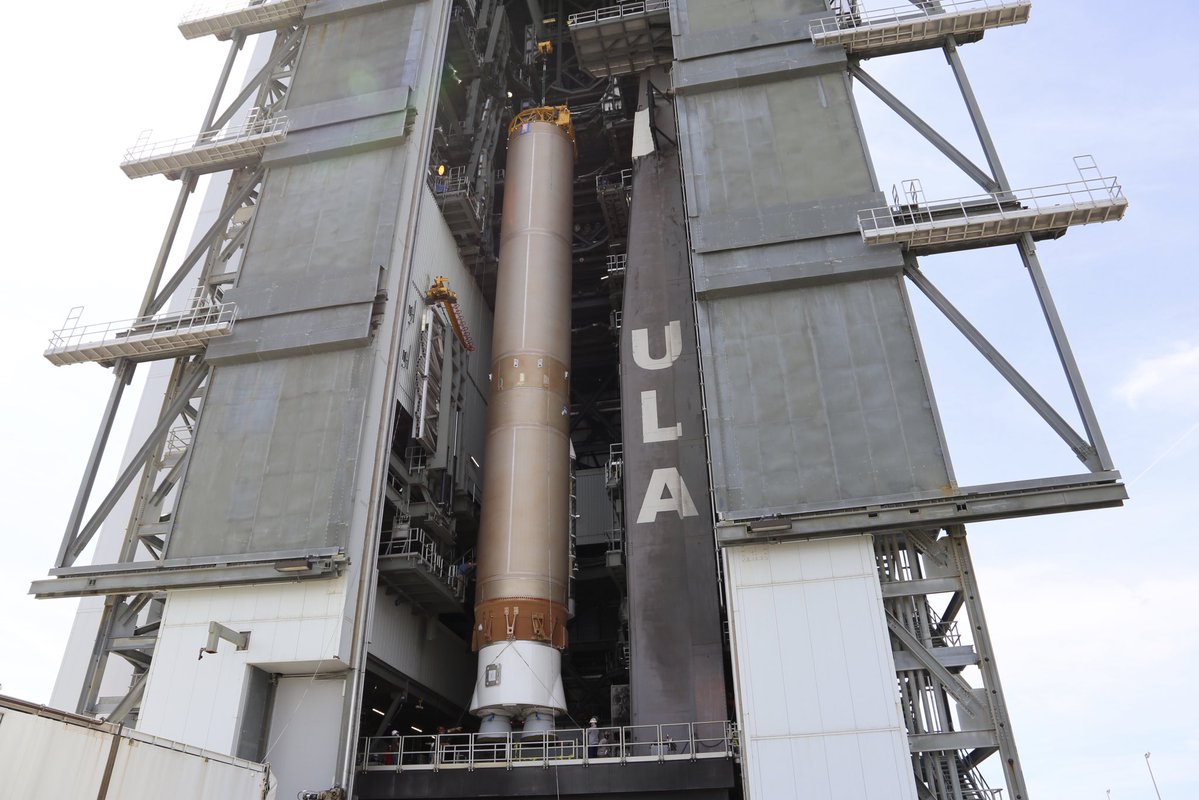
Atmospheric glide tests over the next two years led ultimately to an Air Force decision in late 2006 to develop its own variant of the spacecraft as the Orbital Test Vehicle (OTV) and the first mission flew from April-December 2010, logging 224 days in orbit. A second mission flew 468 days from March 2011 through June 2012, a third completed 675 days between December 2012 and October 2014 and a fourth wrapped up almost 718 days between May 2015 and May 2017.
More recently, the fifth X-37B launched atop SpaceX’s Falcon 9 in September 2017 and returned smoothly to Earth last 27 October, after 780 days aloft. All X-37B missions have launched from the Space Coast, with the first three returning to runway landings at Vandenberg Air Force Base, Calif., and the others terminating at the Shuttle Landing Facility (SLF) at the Kennedy Space Center (KSC).
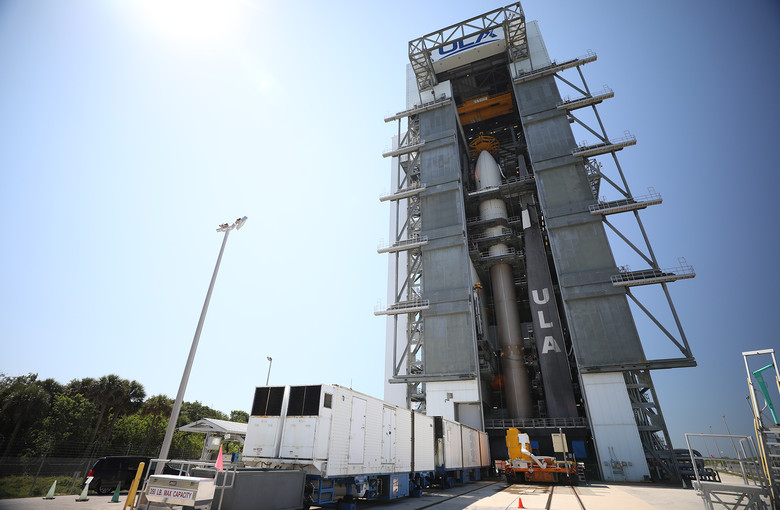
In spite of the secrecy, some snippets of information have crept in the public domain from those five classified missions. In December 2012, the X-37B became the first U.S. autonomous orbital vehicle to complete an end-of-mission runway landing, despite suffering a tire blowout.
The exact nature of its payloads and objectives have often been cloaked in the dry, seemingly meaningless technobabble that is characteristic of secret military missions, although X-37Bs have tested Aerojet Rocketdyne’s XR-5A Hall-effect ion thruster in support of the AEHF program and supported various NASA investigations focused on long-duration materials exposure in the harsh vacuum of low-Earth orbit. And during its most recent mission, which spent 25 months aloft, the X-37B expanded its envelope by flying to a much higher inclination and modified its own orbit using on-board propulsion.
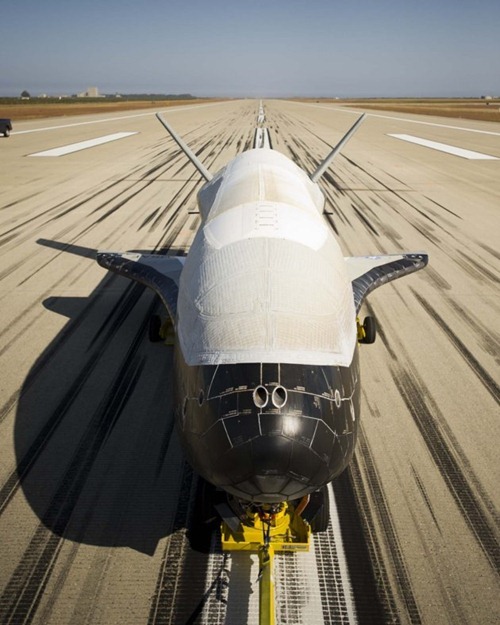
This month’s flight will be the first X-37B mission to use a service module for additional experiment-hosting capability. “This sixth mission is a big step for the X-37B program,” said Randy Walden, Director and Program Executive Officer for the Department of the Air Force Rapid Capabilities Office. “This will be the first X-37B mission to use a service module to host experiments. The incorporation of a service module on this mission enables us to continue to expand the capabilities of the spacecraft and host more experiments than any of the previous missions.”
The mission will deploy the FalconSat-8, a small satellite developed by the U.S. Air Force Academy and sponsored by the Air Force Research Laboratory to conduct several experiments on orbit. The FalconSat-8 is an educational platform that will carry five experimental payloads for USAFA to operate. In addition, a pair of NASA experiments will study radiation and other space effects on a materials sample plate and seeds used to grow food. Finally, the U.S. Naval Research Laboratory will transform solar power into radio frequency microwave energy which could then be transmitted to the ground.
Following the X-37B launch on 16 May, no less than six more missions are planned by ULA for the remainder of the year, bringing 2020’s total to nine. If achieved, this will be the greatest number of flights achieved by the organization since 2016. ULA CEO Tory Bruno recently tweeted that 29 booster cores—a mixture of Atlas V, Delta IV Heavy and as-yet-untried Vulcan hardware—are currently in work for upcoming missions.
A pair of Delta IV Heavy flights are targeted for June and later in the fall to deliver the NROL-44 and NROL-82 payloads for the National Reconnaissance Office; the first launching from the Cape and the second from Vandenberg. And four more Atlas V missions will boost NASA’s Perseverence rover towards Mars in July, refly an uncrewed CST-100 Starliner to the International Space Station (ISS) in the fall and launch NROL-101 for the National Reconnaissance Office and the multi-faceted USSF-8 for the U.S. Space Force.
Quelle: AS
----
Update: 12.05.2020
.
ULA and SpaceX targeting this weekend for back-to-back rocket launches
If schedules hold, United Launch Alliance and SpaceX will highlight this weekend with back-to-back rocket launches, a cadence rarely seen on the Space Coast.
First on the Space Force's calendar is X-37B, a secretive Department of Defense spaceplane that stays in orbit years at a time, testing new systems and capabilities. The 29-foot vehicle will fly on an Atlas V rocket between 6:30 a.m. and 11 a.m. Saturday, though an exact time has not yet been released due to security concerns. Launch Complex 41 will host the attempt.
Though most of the spaceplane's capabilities are classified, the Space Force said the mission known as Orbital Test Vehicle 6 will host more experiments than ever before. Some of those include testing radiation's effects on seeds, transforming solar power to transmissible microwave energy, and how space affects different kinds of materials.
"This will be the first X-37B mission to use a service module to host experiments," Randy Walden of the Air Force Rapid Capabilities Office said in a statement. "The incorporation of a service module on this mission enables us to continue to expand the capabilities of the spacecraft and host more experiments than any of the previous missions."
X-37B, which launches on either Atlas V or SpaceX Falcon 9 rockets, lifts off from Cape Canaveral and lands just a few miles away at Kennedy Space Center's former Shuttle Landing Facility. Its last mission endured a record-breaking 779 days in orbit.
In total, there are two Boeing-built X-37Bs. The spacecraft are owned by the Air Force, but launched, operated, and landed by the Space Force.
On Sunday, meanwhile, a SpaceX Falcon 9 rocket is slated to take flight from neighboring Launch Complex 40 around 4 a.m., though an exact time has not yet been released. Encapsulated in its payload fairing will be 60 Starlink internet satellites, marking the eighth such mission. If successful, the launch will boost the constellation's size to 500 satellites in low-Earth orbit.
After liftoff, Falcon 9's first stage will target a landing on the Of Course I Still Love Youdrone ship before its transport back to Port Canaveral for checkouts and refurbishment.
Though space officials like NASA Administrator Jim Bridenstine are asking spectators to watch launches from home due to the coronavirus pandemic, those outdoors are encouraged to follow the CDC's social distancing and face mask guidelines.
Quelle: Florida Today
----
Update: 14.05.2020
.
Weather looks iffy for weekend launch of X-37B spaceplane from Cape Canaveral
Weather conditions will likely be iffy for this weekend's high-profile launch of an Air Force spaceplane on a United Launch Alliance rocket, local forecasters said Wednesday.
In its forecast, the 45th Space Wing said an area of low pressure could develop into a subtropical depression or storm off the coast of Florida this weekend, possibly impacting Saturday's launch. Liftoff of Atlas V with the X-37B spaceplane is expected at 8:24 a.m.
"The exact location and intensity of this low on Saturday will significantly impact the launch forecast," forecasters said. "The best scenario brings scattered showers and winds 15 to 20 knots, and the worst brings numerous heavy showers and winds near 35 knots."
With the area of low pressure in mind, the weather squadron said Saturday's liftoff from Launch Complex 41 will likely only be 40% "go." In the event of a delay to Sunday, however, conditions could improve to 80% "go."
X-37B is a 29-foot-long, winged spacecraft capable of launching on Atlas V or SpaceX Falcon 9 rockets. After liftoff from Cape Canaveral, it targets landings just a few miles away at Kennedy Space Center's former Shuttle Landing Facility.
Owned by the Air Force but operated by the Space Force, X-37B performs mostly secretive operations in low-Earth orbit. For Saturday's mission, however, some of its objectives were clarified by Secretary of the Air Force Barbara Barrett: experiments include testing how materials react in space, the impact of radiation on seeds, and how solar power can be converted to transmissible energy.
The Boeing-built spacecraft is capable of spending years on orbit – more than any other vehicle to date. Its last mission, which ended in October 2019, totaled a record-breaking 780 days.
As it stands, SpaceX is still targeting just 20 hours after X-37B for the launch of a Falcon 9 rocket with 60 Starlink satellites from neighboring Launch Complex 40. If Atlas V launches on time, SpaceX is then expected to fly at 3:53 a.m. Sunday. But because X-37B is the Eastern Range's first priority, a delay to the mission would also mean Falcon 9 gets delayed, too.
If the missions are able to launch within that 20-hour window, it would mark the fastest turnaround between two Cape Canaveral flights in more than 30 years.
Quelle: Florida Today
----
Update: 16.05.2020 / 10.00MESZ
.
Atlas V & Falcon 9 Set to Launch X-37B & Starlink Missions This Weekend

A United Launch Alliance (ULA) Atlas V heavylifter stands ready to kick off a weekend of back-to-back launches Saturday morning, when it delivers the sixth X-37B Orbital Test Vehicle (OTV) mini-shuttle into low-Earth orbit for the USSF-7 mission on behalf of the U.S. Space Force. And if all goes well, SpaceX will send its frequently-flown B1049 Falcon 9 core on the fifth launch of its career in the small hours of Sunday morning—just 19.5 hours later—to boost another 60 Starlink low-orbiting internet communications satellites aloft. However, with weather conditions expected to be around 40-percent-favorable on Saturday, rising to 80-percent-favorable on Sunday, it remains to be seen if the ULA and SpaceX launch teams can “thread the needle” and fly both missions on schedule.

Quelle: AS
+++
Update: 19.00 MESZ




Quelle: ULA
----
Update: 17.05.2020
.

Quelle: ULA
+++
Update: 16.00 MESZ





































Quelle: ULA
.


